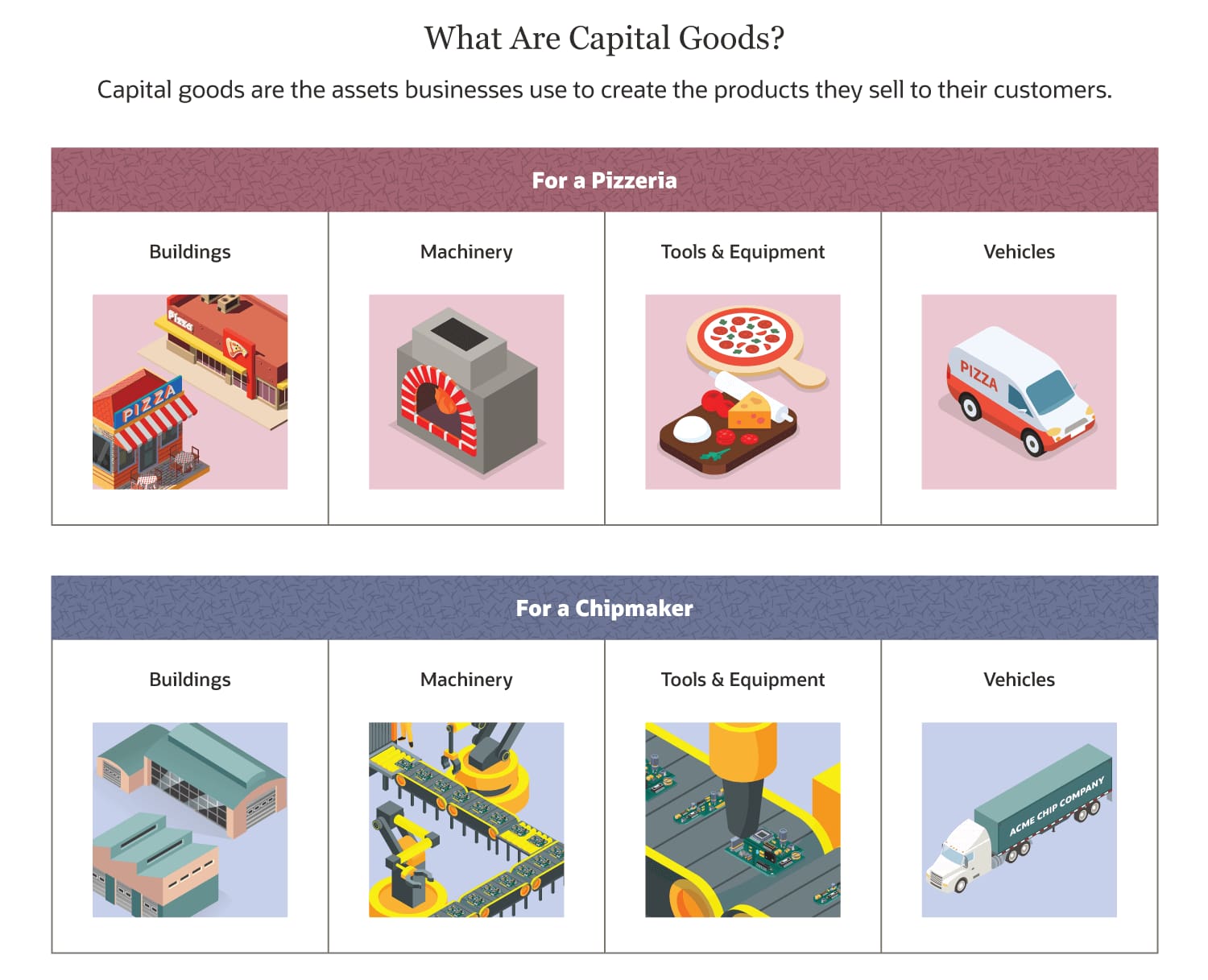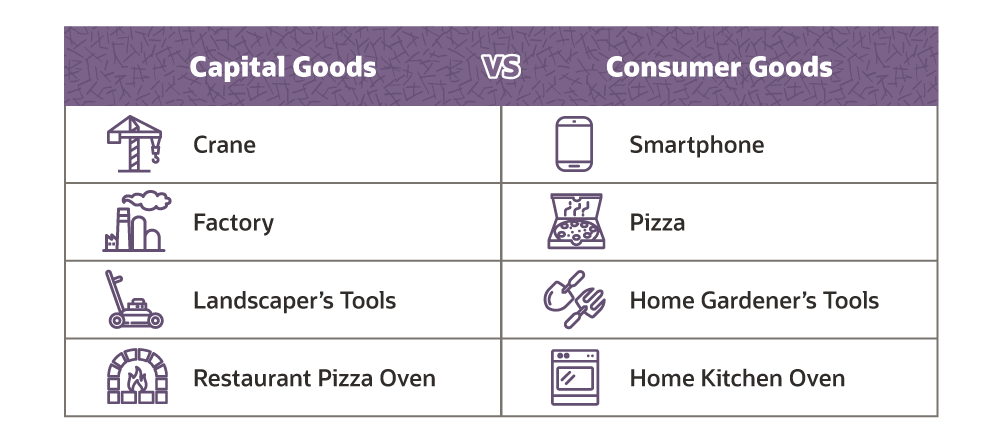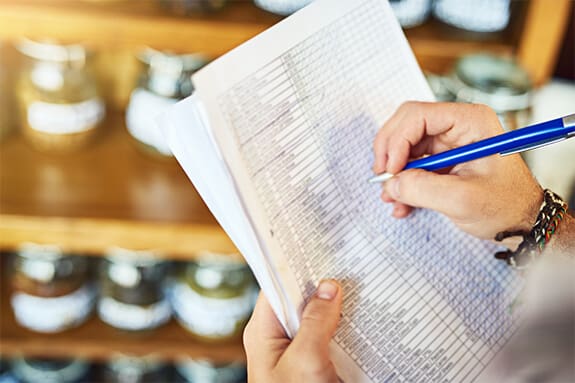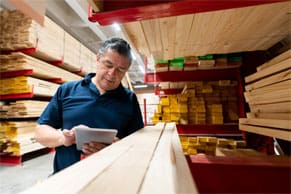Without capital goods there wouldn’t really be any business: Capital goods are the items companies use to create the finished goods and services that they, in turn, offer to their customers. Sometimes considered synonymous with durable goods — since both usually provide value for a very long time — capital goods are the factories, tools and equipment used by businesses in the course of producing their products or providing their services. Because capital goods have such long, useful lives and are so crucial to the operation of businesses, they qualify for special accounting treatment that helps a company better understand its actual cost of doing business for any given period.

What Are Capital Goods?
Capital goods are a business’s physical assets that play a role in production, sometimes called property, plant and equipment (PPE). For a pizzeria, capital goods would include the oven used for cooking, tables and chairs used for dining, and the counters used to assemble and display finished pies for customers. An airline’s biggest expense for capital goods likely are its airplanes, just as semiconductor manufacturing machines are the core capital goods of chip companies. Because they’re intended to last for many years — a factory building, for instance, may last for decades — capital goods are considered a subset of durable goods, which also includes finished goods that last a long time, such as dishwashers, ovens and clothes dryers.
Capital goods often, though not always, come with high price tags — a top-of-the-line pizza oven can cost more than $70,000 and building a semiconductor factory costs billions. What’s more, capital goods might see decades of use creating value for the businesses that buy them. For these reasons, capital goods get a special accounting treatment, involving depreciation, the goal of which is to present a financial view where expenses for a given fiscal period more accurately reflect a company’s real cost of doing business. The concept is simple: Spread out the total cost of buying and owning the capital goods over their entire useful life. So if that state-of-the-art $70,000 pizza oven is expected to last 20 years, the pizzeria that buys it would reflect only one-twentieth of that cost — $3,500 — in its first year of ownership and for every year thereafter, until it’s time to replace the oven. The pizzeria is said to have “capitalized” the cost of the oven, and then will depreciate it over the course of the next 20 years.

Capital Goods vs. Consumer Goods
Capital goods are used to create an end product or provide a service. Consumer goods are finished goods — what a business produces with its capital goods, regardless of whether the product is consumed by individuals or other businesses. Pizzas are the consumer goods sold by pizzerias, transportation is the consumer service sold by the airlines, and microprocessors and other chips are the consumer goods sold by semiconductor companies.
Key Differences
In the end, what often differentiates a capital good from a consumer good is how it is used. Capital goods are assets such as machinery, tools and equipment that are needed to create the consumer good. But the same good can be capital or finished/consumer, depending on who buys it and how they use it. A car you buy to drive around in is a consumer good; the same car purchased by Hertz, or by an Uber driver, is a capital good. Build a wood-burning brick pizza oven in your yard and it’s a consumer good; that same oven is a capital good if you put it in a pizzeria.
Key Takeaways
- Capital goods are assets used in a business’s production process to create a consumable product or provide a service.
- Capital goods are important because, without them, businesses wouldn’t be able to function.
- Capital goods get a special kind of accounting treatment that helps companies better reflect their actual cost of doing business during a given fiscal period.
- Aggregate expenditure for capital goods is considered a good leading indicator for the future health of an economy.
Capital Goods Explained
Capital goods are key to the provision of consumer goods and services. It is impossible to manufacture finished goods like pizza without ovens, or smartphones without factories and equipment that make chips, display screens and all the other components. So, in a very real sense, capital goods are indispensable to businesses. If certain capital machinery or tools are unavailable to a company, it must find an alternative, such as outsourcing certain services from another company, in order to create the needed end product. For example, if an electronics company has a machine that cuts silicon parts in a specific way and it breaks, the company might have to send out its parts to be cut by another company in an effort to continue delivering products to customers while the broken machine is being repaired or replaced.
Why Are Capital Goods Important?
Without reliable capital goods, businesses would not be able to produce products or services. A pizzeria with no oven, or with a broken oven, would not be able to produce pizza. Capital goods are embedded in the processes necessary to build products and services for customers.
As if that weren’t enough, capital goods are also important as an economic indicator. Because of their indispensable role in business, aggregate capital goods expenditure is closely watched by economists and investors. The theory is that when many businesses are investing more in capital goods, those businesses are likely to increase their production and, thereby, promote economic growth. If a lot of ovens are being purchased, then it is reasonable to expect a rise in future business for pizzerias. Of note, the U.S. Commerce Department’s Census Bureau publishes a monthly report on durable goods manufacturers’ shipments, inventories and orders(opens in new tab), which includes a section on capital goods, that is followed by economists and investors as a leading indicator of how the economy will progress in the near future.
How Do Capital Goods Work?
Capital goods have a long, useful life. Since they last a long time and contribute to production over all that time, capital goods are capitalized and then depreciated (or depleted) over time. This accounting treatment allows a business to better understand its real cost of doing business in any given period of time.
Depreciation:
If a pizza oven has an expected life of 20 years, it is listed as an asset on the pizza company’s balance sheet and is expensed over the course of 20 years on the company’s income statement. This means that one-twentieth of the asset’s cost would be expensed each year, and the value of the asset on the balance sheet would decrease by the same amount as the depreciation expense. In the first year of service for that $70,000 pizza oven, for example, the balance sheet would show an asset value for the oven of $66,500 and the income statement would show a depreciation expense of $3,500 against that year’s revenue. In the second year, the oven’s asset value would fall to $63,000 and the same $3,500 expense would hit the income statement. And so on, for 20 years. If the oven is well-maintained and lasts for 25 years, those last five years will be more profitable for the company because the oven has been fully depreciated already — there will be no depreciation expense in those last five years.
Similarly, if the pizzeria decides to add a delivery service, it might purchase a car. If the car has a useful life of five years, the business would be charged one-fifth of the car’s cost as an annual depreciation expense for five years, while the car’s asset value would decrease by 20% each year for five years.
Depletion:
Conceptually, depletion is very similar to depreciation. But while depreciation is applied to purchased assets with known costs and a finite useful life, depletion is applied to natural resources. Companies that operate gold or platinum mines, for example, or that drill for oil or cut down trees to make furniture, etc., must use depletion to account for their use of those natural assets. There are two basic depletion formulas. One, cost depletion, involves estimating the total amount of a given resource that the company believes exists on its property, the amount used (or extracted) in a given period and the cost for doing so. The other depletion formula, percentage depletion, is calculated based on the revenue a company generates from its natural resources multiplied by a percentage published, in the U.S., by the Internal Revenue Service (IRS).
Types of Capital Goods
While fixed assets like buildings and factory machines tend to be the largest and most costly of a company’s capital goods, they’re not the only ones. Smaller electronics, tools and computer hardware are also capital goods. A pizza cutter is an important tool for a pizzeria and, technically, is considered capital goods, while computers and computer programs, such as purchase order software, also are capital goods. For businesses that provide services, capital goods can be items such as buckets, mops and vacuum cleaners for a cleaning business or a car for a taxi service. What these have in common is that they’re necessary to the business’s product or service and are generally long-lasting.
In practice, many companies set minimum thresholds for capitalization and simply expense those items below the threshold. So that pizzeria’s pizza cutter, though technically a capital good, likely wouldn’t make the cut from a corporate accounting perspective. Such smaller items are considered “de minimis”; the IRS allows de minimis expenses.
Examples of Capital Goods
Some items, such as office buildings, are always capital goods. But many others can be capital goods or consumer goods, depending on how they are used and who is using them. Here are some examples of each type.
- Always capital goods: Office buildings, factory assembly lines and offshore oil-drilling platforms.
- It depends: A vacuum used by a cleaning service is a capital good; used at home it’s a consumer good. Cars used for a delivery service are capital goods; used by a family they’re consumer goods. Computers used by a software company are capital goods; used in a household they’re consumer goods.
Conclusion
Capital goods are indispensable to businesses. They’re the long-lasting, and often very costly, assets used to produce a business’s consumable product or service. Because of their typical length of service, capital goods are given a specific accounting treatment in accounting and inventory management systems to help companies better reflect their actual cost of doing business for any given period. And because of their crucial role in economic production, capital goods indexes are closely followed by economists and investors as a leading indicator of near-future economic growth.
Capital Goods FAQs
What are examples of capital goods?
Any asset used by a business in the course of producing the product or service that it sells to customers is considered a capital good. This includes property, plant, equipment and, sometimes, natural resources. For example, a pizza restaurant’s oven, tables and chairs, building and even its slicing implements are considered capital goods. So are office buildings, factory assembly lines and oil-drilling rigs.
What are 4 examples of capital resources?
Capital resources and capital goods are essentially similar; they mostly overlap. Capital goods are the assets used by businesses in the course of producing their products and services, and can include buildings, machinery, tools and equipment. Capital resources is a higher-level concept, defined slightly differently by different scholars. Some define capital resources as all the elements of capital goods plus the funding required to start and/or run a business. Others define it as only the man-made items that go into business production (excluding, for example, natural resources such as oil, minerals and timber). Four examples of capital resources would be: money to start a business; buildings; an office’s copying machine (but not the one in your house); and a garage mechanic’s wrench (but not the one in your personal garage).
What are final goods and capital goods?
Final goods are the products and services businesses create and sell to their customers. Capital goods are the assets a business uses to create the final goods it sells.









